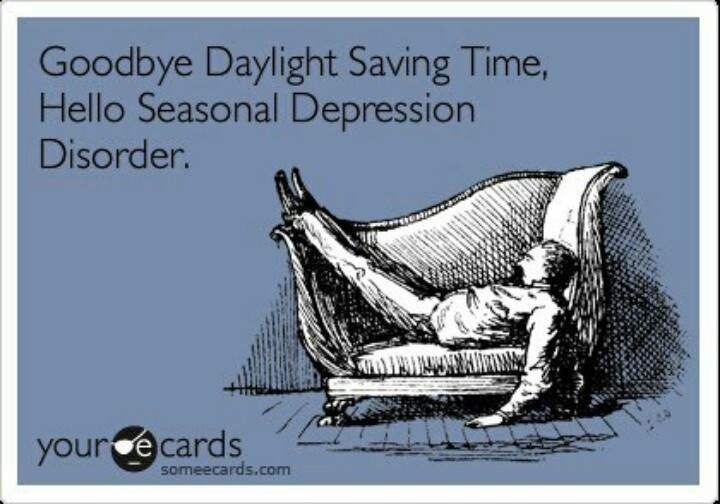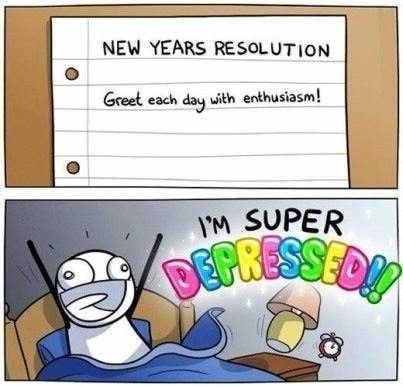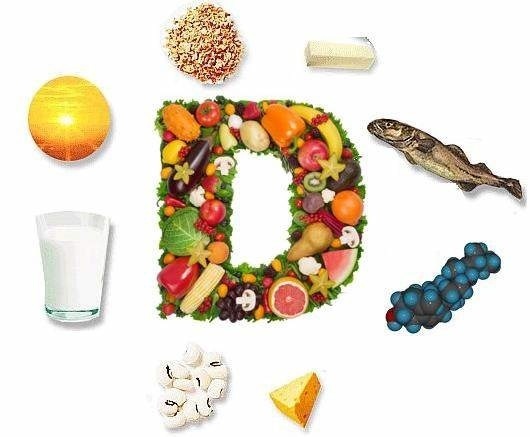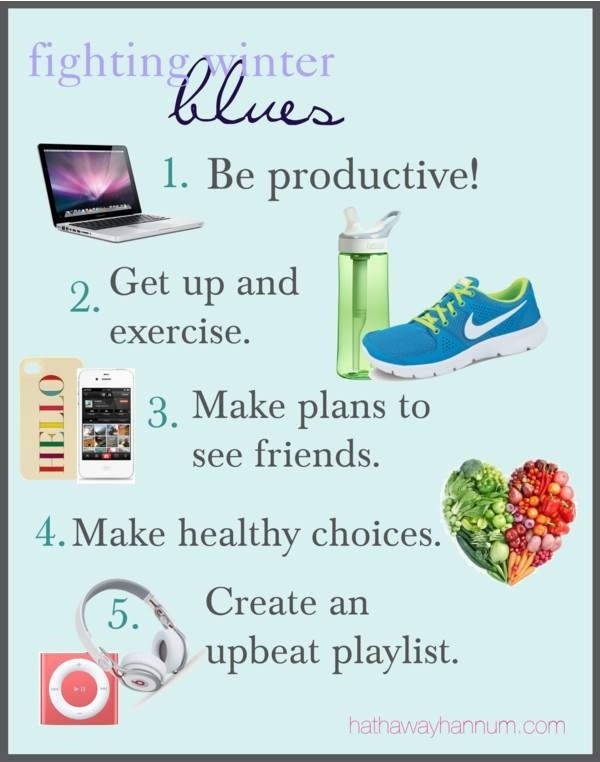 Seasonal Affective Disorder (SAD) is a form of depression arising from the limited exposure to sunlight in the winter (shorter days).
Seasonal Affective Disorder (SAD) is a form of depression arising from the limited exposure to sunlight in the winter (shorter days).
 Seasonal affective disorder affects over ten million people in the United States each year. The average age of onset for SAD is 23 years old and is twice as prevalent in females as males.
Seasonal affective disorder affects over ten million people in the United States each year. The average age of onset for SAD is 23 years old and is twice as prevalent in females as males.
 SYMPTOMS:
SYMPTOMS:
•irritability
•headaches
•extreme fatigue and lethargy
(in low light the pineal gland constantly produces melatonin and a sleepy state is induced)
•increased appetite
•carbohydrate cravings
•an inability to concentrate
•decreased libido
•Weight gain
•Avoiding social interaction (withdrawal) ((It is the long duration of the symptoms that distinguish SAD from the so-called holiday blues.))
((It is the long duration of the symptoms that distinguish SAD from the so-called holiday blues.))
 In Autumn and winter (the yin cycle) there is a tendency towards isolation, sadness, and grieving.
In Autumn and winter (the yin cycle) there is a tendency towards isolation, sadness, and grieving.
For those people whose constitution is more yin in nature due to gender, genetics (over 50% of people who suffer from SAD have at least one first degree relative who has suffered from major depression), environment, and lifestyle, these feelings may be even more pronounced.

Undue physical, mental, or emotional stress, a lack of sleep, and poor nutrition will only deplete the body’s energy further and increase the chances of experiencing not only depressed mood, but depressed immunity. WHAT CAN I DO?
WHAT CAN I DO?
LIGHT
Light therapy is recommended by doctors for winter time blues. Exposure to artificial light may cause headache, Irritability,Eye strain, Inability to sleep and fatigue.
Exposure to sunlight, or if sunlight is not available, sitting near fireplace is the remedy suggested in Ayurveda.
Also: For five minutes each morning stare at and reflect on the color gold. The vibration of the color is similar to natural light and can build stability, as its hue is a balance between fire and earth.
EXERCISE
MOVE!!!! Exercise plays a MAJOR role in the treatment of depression. It stimulates circulation and releases serotonins in the brain, the hormones that encourage contentment and an all around feeling of happiness. It is nature’s best tranquilizer.
Exercise also gives a feeling of accomplishment and thus reduces the sense of helplessness. Some form of active exercise (even dancing to your favorite music), should be undertaken each day at a regular hour. 30 -40 minutes is your goal.

YOGA
The first thing a depressed person stops doing is moving. Regular exercise becomes intolerable. But Yoga exercise, starting with as few as three poses a day in just a few minutes’ time, coupled with correct breath patterns, can become so pleasant to you that soon you will want to do more and more.
Practicing yoga before dawn, in a warm place free of drafts, perhaps by the light of a few candles, can be a gentle way to start the day.
Getting out of bed on a dark, gray winter morning and stepping on a yoga mat is a triumph. Practicing will increase energy, boost mood, and motivate the you to stay out of bed and avoid napping.
Yoga practice also helps keep the pineal gland active longer to produce melatonin in a regulated fashion, normalize the sleep-eat-wake cycle, and eradicate SAD.  ASANAS
ASANAS
Inversions (Stimulate the seventh chakra. Lift attitude, sooth anxiety associated with SAD, stabilize mood. Physically counteracts the slumped shoulders and droopy head associated with depression and stimulates neurotransmitters to release non- epinephrine, dopamine, and serotonin to boost the mood.)
•shoulder stand
•headstand
•handstand
Sun salutations (help to regulate the endocrine system)
Back bends (energizing and uplifting and can be used to help overcome the lethargy associated with SAD & also stimulate the fourth chakra (the heart chakra) This can help with the feelings of hopelessness associated with SAD.)
Spinal twists (release tension in the liver and spleen and sequencing twisting postures can help students release negative or distorted feelings.)
Boat and Warrior (help boost low self-esteem)
Mountain Pose, Chair Pose, and Tree Pose (for inner strength)
((Find more great yoga poses for depression here.))
PRANAYAMA
Emphasize exhalation. Try gently breathing in through the nostrils deep into the belly while mentally counting. Then, exhale and see if you can draw the breath out longer without forcing, to twice the count of the inhalation.
Kapalabhati (breath of fire): This pranayama technique brings light to the front region of the brain and creates a feeling of exhilaration. It creates heat, energizes the mind, and balances and strengthens the nervous system. 
SUPPLEMENTS:
 VITAMIN D
VITAMIN D
Vitamin D is actually a hormone, needs UV B sun exposure in order to be processed in the body
Some studies suggest that as many as 7 out of 10 Americans don’t get enough of this “sunshine vitamin”—particularly during winter.
Need 2000 IU
Food sources include cod, salmon, sardines, herring and fortified cereals and milks.
((Tanning beds provide some UVB exposure and can increase vitamin D levels, but these put you at increased risk for skin cancer.))
OMEGA-3s
Some results suggest that SAD is less common in those who consume more omega-3 fatty acids, such as Icelandic people, who eat plenty of coldwater fish. Oddly enough, people in Iceland appear to be resistant to SAD.
Because our bodies cannot make these essential omega-3 fatty acids, we’ve got to eat them.
Oily, fatty fish (mackerel, herring, salmon, sardines, anchovies) are the best sources of omega-3s because they contain the “more potent” forms of omega-3s
VITAMIN B
vitamin B complex, 100 mgs 3 times daily (Vitamin B deficiency is often a physical cause of depression.)
Plus extra Vitamin B 5, 500 mgs daily (the most potent anti-stress vitamin)
•B-vitamins:
seaweeds (nori, hijiki, and wakame), asparagus, broccoli, bananas, brown rice and figs, whole grains, green veggies, eggs, fish
OTHER HELPFUL VITAMINS
•Vitamin C, 2,000-10,000 mgs daily in divided doses.
•Potassium 80 mgs
•Calcium 1,500-2,000 mgs daily
•Omega-3 oils (flax oil and fish oils):
flax seeds, salmon, sardines, dark green vegetables and walnuts
•magnesium (1,000 mgs per day): ((if you crave carbs, especially chocolate, you may be deficient in magnesium—a mineral involved in the synthesis of serotonin))
quinoa, Brazil nuts, peas, lentils, halibut and spinach.
HERBS
Triphala to support elimination of excess dosha and gently cleanse the colon.
((About 70 percent of the production of serotonin occurs in the digestive tract, so when the digestion is not optimal, it can result in lower production of serotonin.))
Phosphorus is a good choice if you feel worse on cloudy days
Rhus tox relieves the stiffness often provoked by rain.
WHAT SHOULD I EAT?
In the winter it is natural to crave those foods that provide a quick source of energy and that are high in calories since extra energy can be stored as fat in the body to help keep the body warm.  Eat wisely. This means eating sensible, complex carbs to stimulate serotonin. Eating wisely also means watching the caffeine, which suppresses serotonin. If you must drink coffee, save it for after you eat.
Eat wisely. This means eating sensible, complex carbs to stimulate serotonin. Eating wisely also means watching the caffeine, which suppresses serotonin. If you must drink coffee, save it for after you eat.
Make dinner your main carbohydrate-containing meal because evening is usually the time when the symptoms of SAD are at their strongest.
DO NOT over eat.
PROTEINS:
healthy protein sources(at least 3x per day &always pair them with each carbohydrate serving):
•nuts
•Peanut butter
•seeds- pumpkin seeds
•dairy- cottage cheese
•organic meats
•eggs
•lentils
COMPLEX CARBS:
•fruits- apricots gradually raises serotonin levels and helps keep them there, as do apples (with milk and honey!), pears, grapes, plums, grapefruits and oranges.
•grains-Basmati rice. (The sugar in this rice is slow to release into the bloodstream, which helps blood sugar levels stay constant instead of going through highs and lows.) Other foods with a similar effect on blood sugar are rye bread and pasta.
•Cereals-unsweetened muesli, shredded wheat, and bran flakes are slow to release sugar into the bloodstream, which helps raise serotonin levels.
•oatmeal
•vegetables- 4 cups of brightly colored veggies every day
•Popcorn
•pretzels
•low-fat biscotti
•potatoes
ALSO:
•soup and stew
•sprouts
Add turmeric, garlic, ginger, black pepper, cloves and basil to your foods.
((A few helpful meals you can make when you’re SAD.))
DRINKS:
•mint tea
•Blanch 5-7 rosemary leaves in a boiling cup of water, add honey, wait 3 minutes and drink.
•Add some fresh Rose petals to a cup of boiling water. Add sugar and drink whenever feeling depressed.
•Water is essential in any healing process. Distilled water is the best. 6-8 eight ounces glasses per day.
THINGS TO AVOID:
Carbohydrate cravings can contribute to and aggravate feelings of depression by altering blood sugar levels. Drastic changes in blood sugar can lead to weight gain, which is a side effect of SAD.
DO NOT EAT:
white flours
sugars
coffee
alcohol
(try eliminating all white, starchy foods for two weeks — bread, rice, potatoes. You will be amazed at how good you feel but you need to stick to it to see a difference.)
Limit cold drinks and raw vegetables.
 ADDITIONAL TIPS FOR DEALING WITH SAD:
ADDITIONAL TIPS FOR DEALING WITH SAD:
Since our body must already use a lot of energy in the winter to fend off the wind and cold, it is natural to feel more lethargic and emotionally and physically sensitive to our surroundings at this time.
•Allow yourself to rest more.
•Think positive, happy thoughts.
•Try not to worry or be fearful.
•Conserve your energy.
•Practice quiet, yin activities like restorative yoga, Tai Chi, qigong, walking or journaling.
•Rebuild your energy to prepare for spring.
•We have a very primal need to see living, verdant foliage: without it, we feel lost, sad, and hopeless. Go on a shopping spree and find some bright, colorful plants to fill your home.
•Communicate openly with those close to you so that you can nourish your personal relationships
•Enjoy any activity that brings “fire” to your life.
•Encourage the cultivation of joy in your life.

COOL, HELPFUL LINKS:
•I am in love with this UK depression-awareness bakery and their melancholy sweet treats.
•Banish winter blues naturally.
•8 fun strategies to reduce SAD.
•A naturopathic view of SAD.
•A completely excellent yoga guide for SAD.
•BRILLIANT. A playlist of happy songs for handling SAD
Joy Boardman
Massage Therapist and Collage Art Therapist
Planet Joy: Otherworldly Massages for Women, Planet-Friendly Collages for Everyone
Find me here:

I’m a Vata and SO glad that Winter is temporary. :)